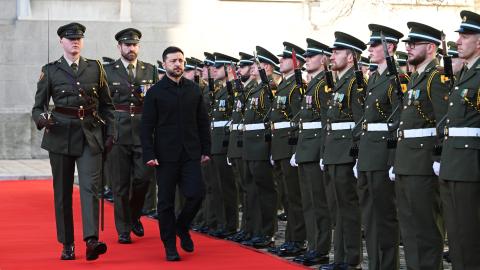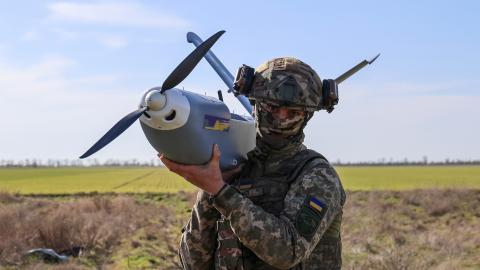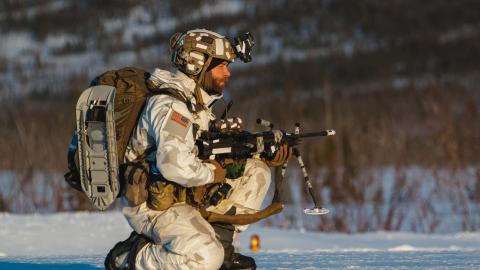Since the Cold War, the United States and many of its North Atlantic Treaty Organization allies have regarded the Arctic as a barren wasteland with no geopolitical significance. But China’s rise and its strategic alliance with Moscow have made the region a tinderbox that could redefine global security. By ignoring the Arctic, NATO risks rendering itself irrelevant in the face of rising Russian and Chinese ambitions.
At the 2025 NATO summit in The Hague, leaders focused on presenting a united front at a time of mounting internal arguments over how to prioritize growing security challenges from actors such as Russia, China, terrorists, and migrants. The difficult decisions on how to spend the 5 percent of GDP that the alliance’s member states agreed to allocate for military expenditures by 2035 have yet to take place. When these difficult talks take place, NATO must prioritize building a credible defense force posture in the Arctic, as Russia and China expand their strategic presence in the alliance’s northern flank.
Economically, Russia’s Arctic coastline has tremendous potential for shipping, energy, and fishing ventures. In 2024, the Arctic accounted for 7.5 percent of the country’s GDP. This figure is likely to increase. As sea ice is melting, Moscow is advertising the Northern Sea Route as a time- and money-saving link for the shipping industry, logging 38 million tons in 2024. The route is Russia’s national maritime waterway, generating substantial revenue from oil and liquefied natural gas extracted in the Arctic region and transported to Asia with costly icebreaker assistance. At an estimated $19.2 billion in 2025, Arctic fisheries are also an important source of revenue.
Rising Arctic commercial traffic creates control problems, threatening Moscow’s strategic assets. Russia has therefore been transforming its Arctic coast into a modern maritime fortress. Its growing fleet of submarines, including nuclear-powered ballistic missile subs lurking near the Barents Sea, poses a direct threat not just to regional stability but to the U.S. homeland. Moscow is also investing heavily in autonomous underwater vehicles and upgrading its Northern Fleet bases, aiming for sea denial and nuclear deterrence—trends that should concern Western defense officials.
Meanwhile, China is evolving from a distant observer to an active participant in the Arctic. Russia is a leading exporter of liquefied natural gas (LNG), oil, and fish from the Arctic to China, and China has invested heavily in these industries. As the EU is phasing out Russian LNG, cargoes are increasingly shipped to the Chinese market. Moscow relies on Beijing’s financial resources and technological prowess to build a credible Arctic defense. The two are connecting Russia’s Arctic ports to China’s Polar Silk Road, forging logistical networks that enhance interoperability. In 2024, a Russia-Chinese joint venture announced plans to build and operate five ice-class container ships with dual-use potential all-year round on the Northern Sea Route. While China currently maintains a limited military footprint—just a handful of icebreakers and polar research vessels—the potential for strategic expansion is evident. Next-generation submarines, hypersonic missiles, and space-based systems could someday allow China to project power across the Arctic.
NATO’s Arctic member states are woefully unprepared for this new reality. Only recently has the alliance truly begun to prioritize Arctic security, through exercises like Dynamic Mongoose and Nordic Response. Yet NATO still lacks the critical infrastructure—polar-capable ships, surveillance systems, missile defense, and sealift capacity—that would make it a credible force in the Arctic. The alliance’s approach is reactive rather than strategic. NATO nations has announced some promising Arctic defense investments such as Canada’s plans to acquire missile defense systems and Denmark’s commitment to strengthen surveillance around Greenland. But NATO nations need to demonstrate real-world capabilities and increased coordination with allies before they can truly restore credibility to the alliance’s Arctic force posture.
What’s missing? A cohesive Arctic strategy that unites NATO members with stakes in the region—Canada, Denmark, Finland, Iceland, Norway, Sweden, and the U.S. NATO’s advantage is that its Arctic states share common concerns rooted in geography and security interests.
The answer is not broad, diffuse involvement. Finland and Sweden’s NATO membership has fueled Russia’s sense of encirclement and vulnerability. Moscow now views the Arctic as a potential conflict zone, making increased alliance presence and preparedness more urgent to prevent future incursions. At the same time, NATO should bolster cooperation among Arctic members with legal regional rights and responsibilities such as patrolling and environmental protection to avoid unnecessary escalation. Critical next steps include extending existing agreements like the ICE Pact to include the UK—positioned perfectly at the vital Greenland–Iceland–United Kingdom (GIUK) gap—and develop tailored plans for deterrence. Imagining an expanded Arctic pact, with clear priorities like missile defense sites along East Greenland to intercept Russian and Chinese threats, makes strategic sense.
Further, enhancing situational awareness through polar satellites, autonomous vehicles, and more icebreakers is essential. In the long term, NATO must plan for increased submarine and surface warfare capabilities, logistics, and infrastructure investments—covering ports, command and control systems, and industrial bases. The goal: build a resilient, credible deterrent capable of operating year-round in one of the world’s most extreme environments.
But investing in Arctic defenses isn’t cheap. Tensions across Europe and the Indo-Pacific compete for limited resources. That is why NATO must recognize that Arctic security is not a bonus; it is vital to the alliance’s future to include Arctic defense in future alliance commitments and spending targets. Transatlantic defense investments are likely to spin off commercial investments in Arctic industries such as minerals, energy, and infrastructure. This would give a much-needed boost to regional economies such as Alaska and Canada’s northern territories, which now account for less than one percent of each economy’s gross production figures.
If NATO fails to adapt to the Arctic’s renewed importance, it risks being cold shouldered in tomorrow’s Arctic conflicts.















